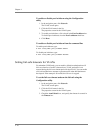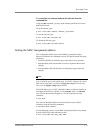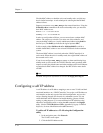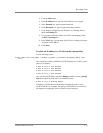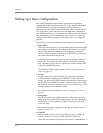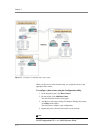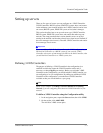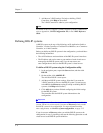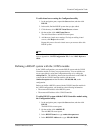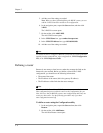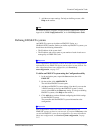
Chapter 5
5 - 2
Setting up a basic configuration
Each 3-DNS Controller in the network setup must have information
regarding which data center houses specific servers, and with which other
3-DNS Controllers it can share configuration and load balancing
information. A basic network setup includes data centers, servers, and one
sync group. Once you have the basic network components configured on
your 3-DNS Controller, you can set up the wide IPs you need for managing
your load balancing. We recommend that you review the load balancing
solutions in the remaining chapters of this guide before you configure the
wide IPs.
The following sections describe the various elements of a basic network:
◆ Data centers
Data centers are the top level of your network setup. We recommend that
you configure one data center for each physical location in your global
network. The data center element of your configuration defines the
servers (3-DNS Controllers, BIG-IP systems, EDGE-FX systems, hosts,
and routers) that reside at that location.
A data center can contain any type of server. For example, in Figure 5.1
on page 5-4, the Tokyo data center contains a 3-DNS Controller and a
host, while the New York and Los Angeles data centers contain 3-DNS
Controllers and BIG-IP systems.
For information about configuring data centers, see Setting up a data
center, on page 5-3.
◆ Servers
The data center servers that you define in the network setup include
3-DNS Controllers, BIG-IP systems, EDGE-FX systems, hosts, and
routers. You define the 3-DNS Controllers that manage load balancing to
the BIG-IP systems, EDGE-FX systems, and hosts, and you also define
the virtual servers that are managed by the servers. Virtual servers are the
ultimate destination for connection requests.
For information about configuring servers, see Setting up servers, on
page 5-5.
◆ Sync groups
Sync groups contain only 3-DNS Controllers. When setting up a sync
group, you define which 3-DNS Controllers have the same configuration.
In most cases, you should define all 3-DNS Controllers as part of the
same sync group.
For information about configuring sync groups, see Working with sync
groups, on page 5-13.
◆ Wide IPs
After you define virtual servers for your BIG-IP systems, EDGE-FX
systems, and hosts, you need to define wide IPs to specify how
connections are distributed among the virtual servers. A wide IP maps a



